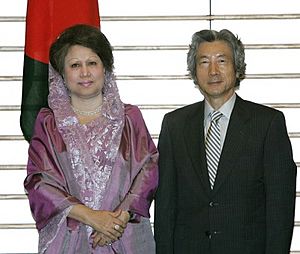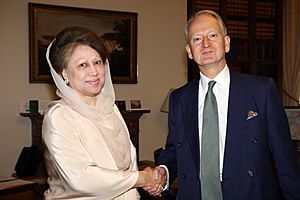Khaleda Zia facts for kids
Quick facts for kids
Khaleda Zia
|
|
|---|---|
|
খালেদা জিয়া
|
|
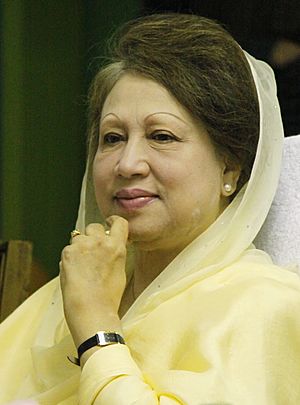
Zia in 2010
|
|
| 9th Prime Minister of Bangladesh | |
| In office 10 October 2001 – 29 October 2006 |
|
| President | |
| Preceded by |
|
| Succeeded by |
|
| In office 20 March 1991 – 30 March 1996 |
|
| President | |
| Preceded by | Kazi Zafar Ahmed |
| Succeeded by |
|
| 3rd Chairperson of the Bangladesh Nationalist Party | |
| Assumed office 10 May 1984 |
|
| General Secretary |
|
| Preceded by | Abdus Sattar |
| 4th Leader of the Opposition | |
| In office 29 December 2008 – 9 January 2014 |
|
| Prime Minister | Sheikh Hasina |
| Preceded by | Sheikh Hasina |
| Succeeded by | Rowshan Ershad |
| In office 23 June 1996 – 15 July 2001 |
|
| Prime Minister | Sheikh Hasina |
| Preceded by | Sheikh Hasina |
| Succeeded by | Sheikh Hasina |
| 2nd First Lady of Bangladesh | |
| In role 21 April 1977 – 30 May 1981 |
|
| President | Ziaur Rahman |
| Preceded by | Sheikh Fazilatunnesa Mujib |
| Succeeded by | Rowshan Ershad |
| 7th Leader of the House | |
| In office 10 October 2001 – 29 October 2006 |
|
| Preceded by | Sheikh Hasina |
| Succeeded by | Sheikh Hasina |
| In office 20 March 1991 – 30 March 1996 |
|
| Preceded by | Kazi Zafar Ahmed |
| Succeeded by | Sheikh Hasina |
| Member of Parliament | |
| In office 29 December 2008 – 9 January 2014 |
|
| Preceded by | Sayeed Iskander |
| Succeeded by | Shirin Akhter |
| Constituency | Feni-1 |
| In office 1 October 2001 – 29 October 2006 |
|
| Preceded by | Zafar Imam |
| Succeeded by | Muhammad Jamiruddin Sircar |
| Constituency | Bogra-6 |
| In office 20 March 1991 – 15 July 2001 |
|
| Preceded by | Zafar Imam |
| Succeeded by | Sayeed Iskander |
| Constituency | Feni-1 |
| Personal details | |
| Born |
Khaleda Khanam Putul
15 August 1945 Jalpaiguri, Bengal Presidency, British India |
| Political party | Bangladesh Nationalist Party (1979–present) |
| Other political affiliations |
|
| Spouse | |
| Children |
|
| Relatives | See Majumder–Zia family |
| Awards | Full list |
| Signature | |
Begum Khaleda Zia (born in 1945) is a famous politician from Bangladesh. She served as the prime minister of Bangladesh two times. Her first term was from 1991 to 1996, and her second was from 2001 to 2006. She was the first female prime minister of Bangladesh. She was also the second female prime minister in the Muslim world, after Benazir Bhutto.
Khaleda Zia is the widow of Ziaur Rahman, who was a former president of Bangladesh and army commander. Since 1984, she has been the leader of the Bangladesh Nationalist Party (BNP). Her husband, Ziaur Rahman, founded this party in 1978.
Khaleda Zia first became well-known as the First Lady of Bangladesh. This was after her husband, Rahman, became president in 1977. After Rahman's death in 1981, Khaleda Zia entered politics. She quickly rose to lead the BNP. In 1982, after a military takeover, she helped lead the movement for democracy.
She became prime minister after her party won the 1991 Bangladeshi general election. She served until 1996. Her party won again in 2001, and she was prime minister until 2006. After her government's term ended in 2006, elections were delayed. This led to political unrest and a military-backed government taking over. This government accused Zia and her two sons of corruption.
In 2018, Zia was sentenced to prison in corruption cases. However, she was released on house arrest in March 2020 for medical reasons. Later, in August 2024, she was fully released after a large public uprising. On November 27, 2024, and January 15, 2025, she was found not guilty in these corruption cases.
Contents
Personal Life and Family Background
Early Life and Education
Khaleda Khanam "Putul" was born in 1945 in Jalpaiguri, which was then part of British India. Her family's original home is in Fulgazi, Feni, Bangladesh. She was the third of five children. Her father, Iskandar Ali Majumder, was a tea businessman. Her mother was Taiyaba Majumder.
After India was divided in 1947, her family moved to Dinajpur, which is now in Bangladesh. Khaleda Zia describes herself as "self-educated." She attended Dinajpur Missionary School and later Dinajpur Girls' School. In 1960, she married Ziaur Rahman, who was a captain in the Pakistan Army. After marriage, she changed her name to Khaleda Zia. She moved to West Pakistan in 1965 to live with her husband. In 1969, they moved back to East Pakistan.
Family Members

Khaleda Zia's first son, Tarique Rahman (born 1967), became involved in politics. He is now the acting chairman of the Bangladesh Nationalist Party. Her second son, Arafat Rahman "Koko" (born 1969), passed away in 2015.
Her sister, Khurshid Jahan (1939–2006), served as the Minister of Women and Children Affairs from 2001 to 2006. Her younger brother, Sayeed Iskander (1953–2012), was also a politician. He was a member of the Jatiya Sangsad (parliament). Her other brother, Shamim Iskandar, is a retired flight engineer. Her second sister is Selina Islam.
Journey into Politics
On May 30, 1981, Khaleda Zia's husband, President Ziaur Rahman, was tragically killed. After his death, she decided to enter politics. On January 2, 1982, she became a member of the Bangladesh Nationalist Party (BNP). This party was founded by her husband. In March 1983, she became the vice-chairman of BNP.
Leading the Anti-Ershad Movement
In March 1982, the head of the Bangladesh Army, Hussain Muhammad Ershad, took control of the country. He launched a coup against President Abdus Sattar. This started a nine-year period of military rule in Bangladesh.
Forming Alliances Against Military Rule
From the very beginning of Ershad's rule, Begum Khaleda Zia strongly opposed the military government. She became the Senior Vice-President of BNP by May 1983. Under her leadership, BNP began talks with six other parties. They aimed to form a united movement. By September 1983, they created the '7-party alliance'. BNP, led by Khaleda Zia, also agreed with other parties to protest against Ershad.
On September 30, 1983, Khaleda Zia led a major public rally. Party workers cheered for her. On November 28, 1983, she joined a "Gherao movement" (encircling) the Secretariat building in Dhaka. Ershad's police stopped the protest, and she was placed under house arrest that same day.
Due to health issues, Justice Abdus Sattar resigned as BNP chief in January 1984. Begum Khaleda Zia took his place. In May 1984, she was elected as the party's chairperson.
Leading Protests and Boycotts
As party chief, Khaleda Zia led the movement against Ershad. In 1984, she declared February 6 as 'Demand Day' and February 14 as 'Protest Day'. Rallies were held across the country. Activists died fighting the police loyal to President Ershad.
The 7-party alliance held a 'Mass Resistance Day' on July 9, 1984. They demanded an end to martial law. They called for protests from September 16 to 20 and a full day strike on September 27, 1984. Protests continued in 1985. In March, Ershad's government tightened martial law. Begum Khaleda Zia was again put under house arrest.
In 1986, Lt. General Ershad announced a new election. Khaleda Zia declared the election illegal. She urged people not to participate. The government put her under house arrest before the election. Her strong stand against the military government made her known as an "uncompromising leader."
The Fall of Ershad's Government
Khaleda Zia was placed under house arrest many times from 1986 to 1990. This was done by Ershad's military government. She led a new movement to remove Ershad. She called for strikes and rallies. These protests often turned violent.
In 1990, BNP's student group, Chatra Dal, won many student union elections. This showed Khaleda Zia's growing popularity. On October 10, 1990, a Chatra Dal leader died in clashes. This led to a bigger alliance of all opposition groups. After two months of protests, BNP, led by Khaleda Zia, and other parties forced Ershad to resign on December 4, 1990.
Serving as Prime Minister
Begum Khaleda Zia served as the Prime Minister of Bangladesh three times. Her first term was from March 1991 to February 1996. Her second term was very short, lasting only a few weeks in 1996. Her third term was from October 2001 to October 2006. She is remembered for making education more available and for introducing important economic changes.
First Term: 1991-1996
After eight years of Ershad's rule, a neutral government held elections on February 27, 1991. BNP won 140 seats, just short of a majority. Zia became the country's first female prime minister on March 20, 1991. The parliament then voted to change the constitution. This officially ended 16 years of presidential rule. Bangladesh became a parliamentary system again.
Improving Education
When Begum Khaleda Zia became prime minister in 1991, children in Bangladesh received about two years of schooling on average. For every three boys, there was only one girl in the classroom. Her government worked hard to improve education and job training. They made primary education free and required for everyone. Education was also made free for girls up to the 10th grade.
To pay for these changes, the education budget was increased by 60% in 1994. This was the largest increase among all government spending areas. Thanks to her policies, the pass rate for the SSC examination (a major school exam) greatly improved. In 1990, only about 31% of students passed. By 1995, about 73% passed, including over 71% of female students.
Economic Changes
Khaleda Zia's first government brought in major economic changes. These included introducing Value Added Tax (VAT). They also created new laws for banks in 1991 and financial institutions in 1993. A board for privatization was set up in 1993. Bangladesh also signed the General Agreement on Tariffs and Trade in 1993. A new export processing zone was created near Dhaka in 1993. This was done to attract foreign businesses to invest in the country.
Government Reforms
To meet public demand, Khaleda Zia's government passed a law. This law allowed city mayors to be directly elected by voters. Before this, mayors were chosen by elected ward councilors. Her government also changed the local government system. They formed a commission that suggested a two-level system of local government.
Second Term: 1996
In February 1996, the opposition parties refused to take part in the election. Zia's party, BNP, won almost all the seats. Other major parties demanded a neutral caretaker government to oversee elections. The parliament quickly passed a law to create this caretaker government. The parliament was then dissolved to prepare for new elections within 90 days.
In the June 1996 elections, BNP lost to Sheikh Hasina's Awami League. BNP won 116 seats. It became the largest opposition party in Bangladesh's parliamentary history.
Third Term: 2001-2006
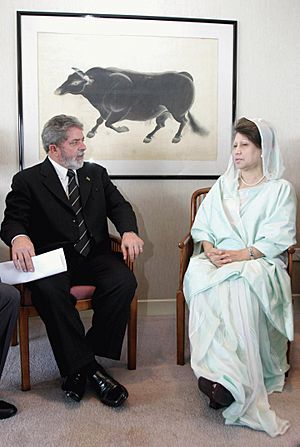
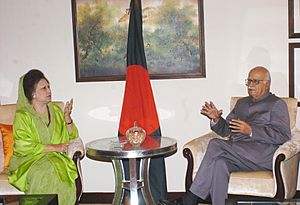
BNP formed an alliance with three other parties in January 1999. This was to improve their chances in the next elections. This alliance included the Jatiya Party and Islamic parties. They encouraged protests against the Awami League government.
The four-party alliance took part in the October 1, 2001, general elections. They won two-thirds of the seats in parliament. Zia was sworn in as Prime Minister of Bangladesh. She worked on a 100-day plan to fulfill her election promises. During this time, Bangladesh attracted more international investment. This helped develop the country's infrastructure, energy, and businesses. Restoring law and order was also a key achievement.
Zia promoted good relationships with neighboring countries. She worked to improve cooperation in South Asia. Her government also supported UN peacekeeping efforts. In 2006, Forbes magazine praised her government's achievements. Her government worked to educate young girls and provide food for the poor. It also supported strong economic growth.
When Zia became prime minister for the third time, Bangladesh's economy grew by over 6 percent. The average income per person rose to 482 dollars. Foreign currency reserves increased from 1 billion to over 3 billion dollars. Foreign investments also grew to 2.5 billion dollars. The industrial part of the economy grew to over 17 percent by the end of her term.
On October 29, 2006, Zia's term ended. A caretaker government was supposed to manage the country for 90 days until new elections. However, there was unrest over who would lead this caretaker government. President Iajuddin Ahmed took over as Chief Advisor. He tried to arrange elections and bring all political parties together. But months of violence followed. In January 2007, the military stepped in to support the caretaker government for a longer period. This government held power until elections in December 2008.
After Being Prime Minister (Since 2006)
Detention During Caretaker Government
Fakhruddin Ahmed, a former central bank governor, became the Chief Adviser of the caretaker government on January 12, 2007. In March, Zia's oldest son, Tarique Rahman, was arrested for corruption. The government also stopped politicians from visiting Zia's home. Her other son, Arafat Rahman, was arrested for corruption in April. On September 3, Zia was arrested on corruption charges related to government contracts. She was held in a temporary prison.
Zia was released on bail on September 11, 2008, after being held for a year. In December 2008, the caretaker government held general elections. Zia's party lost to the Awami League. Sheikh Hasina became prime minister. Zia then became the leader of the opposition in parliament.
Leaving the Cantonment House
Zia's family had lived for 38 years in a house in Dhaka Cantonment. This was her husband's official home when he was an army officer. After he became president, he kept the house. After his death in 1981, the acting president leased the house to Zia for life for a very small fee.
In April 2009, the military asked Zia to leave the house. They said she was using it for political activities, which was against the rules. They also said a civilian could not live in a cantonment. Zia left the house on November 13, 2010. She then moved to her brother's home in Gulshan.
Boycotting the 2014 Election
Zia's party decided not to take part in the 2014 Bangladeshi general election. They demanded that the election be held under a non-political caretaker government. However, Prime Minister Sheikh Hasina rejected this demand. The Awami League, led by Hasina, won the election.
In 2016, BNP announced its new leadership committee. Zia remained its chairperson.
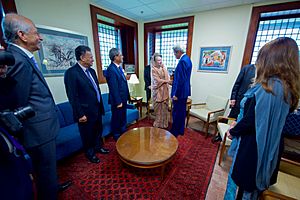
In 2017, police searched Zia's house for "anti-state" documents.
Legal Cases and Release in 2024
In 2008, during the caretaker government, a corruption case was filed against Zia. She was accused of misusing funds meant for orphans. On February 8, 2018, she was sentenced to prison in this case. Her party said the verdict was politically unfair. She was sent to the Old Dhaka Central Jail. On October 31, 2018, a higher court increased her jail term to 10 years.
On October 30, 2018, in another case, the Zia Charitable Trust graft case, Zia was sentenced to 7 years in prison. She was also accused in many other cases. Because of her prison sentences, Zia could not run in the 2018 general election. Her party lost that election.
Zia was admitted to Bangabandhu Sheikh Mujib Medical University for medical treatment in April 2019. Her requests for bail due to health reasons were denied several times. On March 25, 2020, Zia was released from prison for six months. This was on the condition that she stay at her home and not leave the country. This release was extended several times.
After the government led by Sheikh Hasina was removed in August 2024, Khaleda Zia was acquitted in several cases. On November 27, 2024, she was found not guilty in the Charitable Trust graft and Barapukuria graft cases. On January 15, 2025, she was acquitted in the orphanage trust graft case.
2024 Release and Recent Events
After Sheikh Hasina was removed as prime minister during the 2024 non-cooperation movement, President Mohammed Shahabuddin ordered Khaleda Zia's release on August 5, 2024. Soon after, she made her first public statements since 2018. She praised the "brave people" who made her release possible. She also asked for "love and peace" to rebuild Bangladesh. On August 13, her police escort privileges, which had been removed in 2015, were restored. On August 19, her bank accounts, frozen since 2007, were unfrozen.
Health Concerns
Zia has been dealing with several health issues. These include chronic kidney problems, liver disease, unstable blood levels, diabetes, and arthritis. In April 2021, she tested positive for COVID-19 but recovered without symptoms. In November 2021, doctors announced she was suffering from liver cirrhosis. She has received treatment at Evercare Hospital in Dhaka multiple times.
On January 7, 2025, Zia traveled to London for medical treatment. She was admitted to The London Clinic on January 8, 2025.
Eponyms
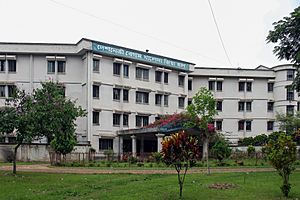
Several residential halls at universities in Bangladesh are named after Begum Khaleda Zia:
- Begum Khaleda Zia Hall at Islamic University, Kushtia.
- Deshnetri Begum Khaleda Zia Hall at the University of Chittagong.
- Begum Khaleda Zia Hall at Jahangirnagar University.
- Begum Khaleda Zia Hall at the University of Rajshahi.
See also
 In Spanish: Jaleda Zia para niños
In Spanish: Jaleda Zia para niños



